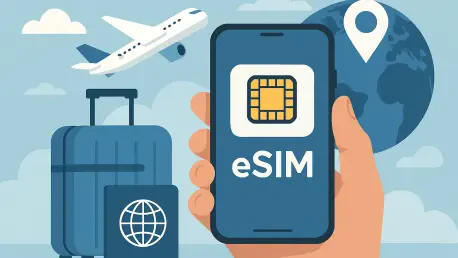Imagine stepping off a plane in a foreign land, eager to explore ancient cobblestone streets or bustling cityscapes, only to be halted by the daunting task of securing a reliable internet connection. For countless travelers, staying connected abroad has historically been a frustrating mix of exorbitant roaming fees and the tedious hunt for local SIM cards. However, a transformative solution has emerged with eSIM technology, which is reshaping how people maintain connectivity across Europe and the United States. This digital innovation offers a streamlined alternative to outdated methods, ensuring that whether someone is marveling at the Colosseum in Rome or closing a deal in Los Angeles, they can stay online without the usual headaches. By embedding a digital chip directly into devices, eSIM eliminates the need for physical swaps and provides a user-friendly way to manage multiple carrier profiles. This breakthrough is not just a convenience but a fundamental shift in global travel, promising seamless communication for tourists and professionals alike.
Overcoming Traditional Travel Connectivity Barriers
The challenges of staying connected while traveling internationally have long been a thorn in the side of globetrotters. High roaming charges often lead to shocking bills upon returning home, while the process of acquiring a local SIM card can involve navigating unfamiliar languages, store policies, and compatibility issues with devices. eSIM technology directly addresses these pain points by allowing travelers to select and activate data plans digitally before even leaving their home country. This means no more waiting in long lines at airport kiosks or risking disconnection during critical moments. Instead, users can ensure they’re online the moment their flight touches down, whether they’re landing in Berlin or Boston. The simplicity of managing plans through a smartphone app or settings menu transforms a once stressful ordeal into a quick, efficient task, letting travelers focus on their journey rather than logistics.
Beyond just eliminating logistical hurdles, eSIM offers a financial reprieve from the steep costs associated with traditional connectivity options. Roaming fees, often hidden in fine print, can accumulate rapidly, turning a simple trip into a budget-breaking experience. With eSIM, transparent pricing and prepaid plans provide clarity and control over expenses. Travelers can compare options from various carriers in Europe and the USA, selecting packages that align with their specific needs without the fear of unexpected charges. This cost-effectiveness is particularly beneficial for frequent travelers or those on extended trips, as it prevents the need to repeatedly purchase new SIM cards or top up balances. Additionally, the ability to store multiple profiles on a single device means switching between plans for different countries or regions is effortless, further reducing both cost and inconvenience during multi-destination itineraries.
Europe’s Fertile Ground for eSIM Adoption
Europe stands as a beacon of progress for eSIM technology, thanks to a regulatory landscape that fosters seamless connectivity. The European Union’s decision to abolish intra-regional roaming charges has already made travel within the bloc more accessible, and eSIM builds on this foundation by offering plans that span multiple countries with a single activation. A traveler can move from the canals of Amsterdam to the vineyards of Tuscany without worrying about changing plans or losing service. Supported by widespread high-speed 4G and the gradual rollout of 5G networks, eSIM users in Europe experience reliable, fast internet across diverse terrains. This infrastructure ensures that whether someone is posting photos from a Parisian café or joining a virtual meeting from a remote Greek island, connectivity remains consistent and dependable.
Moreover, the cultural and geographic diversity of Europe amplifies the value of eSIM for travelers. With dozens of countries packed into a relatively small area, crossing borders is a common occurrence, often multiple times in a single trip. eSIM plans tailored for regional coverage eliminate the need to juggle different carriers or face connectivity gaps during these transitions. Providers have capitalized on this demand by offering competitive packages that cater to short-term visitors and long-term explorers alike, often including generous data allowances for navigation, translation apps, and social sharing. The ease of activating these plans digitally also aligns with Europe’s tech-savvy population and tourist demographic, who increasingly expect instant, hassle-free solutions. As adoption grows, Europe continues to set a standard for how integrated digital connectivity can enhance the travel experience across varied landscapes.
eSIM’s Stronghold in the American Market
In the United States, eSIM technology has gained significant traction, driven by early adoption among major carriers and a highly competitive telecommunications market. American providers have rolled out feature-rich plans that cater to the diverse needs of both domestic residents and international visitors, offering perks like unlimited domestic calls and substantial data packages for streaming or social media use. Given the vast size of the country, with its sprawling cities and remote national parks, eSIM ensures connectivity even in areas where coverage might vary. Travelers exploring iconic destinations like the Grand Canyon or navigating the urban sprawl of New York City can rely on pre-configured plans that prioritize reliability and speed, making eSIM an indispensable tool for seamless communication.
Competition among US carriers has further fueled innovation in eSIM offerings, resulting in consumer-friendly pricing and tailored services. Unlike the fragmented approach of physical SIM cards, which often require separate purchases for different states or regions, eSIM allows users to access nationwide coverage through a single digital profile. This is particularly advantageous for road trips or multi-city itineraries, where maintaining a consistent connection is crucial for navigation and safety. Additionally, the integration of eSIM into the latest smartphones and tablets reflects a broader trend of device manufacturers aligning with carrier advancements, ensuring compatibility and ease of use. As the market continues to evolve, the USA remains a leader in demonstrating how eSIM can meet the demands of a mobile, tech-driven society, setting a benchmark for other regions to follow.
Navigating the Choice of eSIM Plans
Selecting an appropriate eSIM plan is a critical step for travelers aiming to maximize the technology’s benefits. Key considerations include assessing data requirements based on intended usage—whether it’s casual browsing for maps and messaging or intensive activities like video conferencing and streaming high-definition content. Trip duration also plays a significant role, as providers offer flexible options ranging from daily to monthly plans, accommodating both weekend getaways and extended stays. Coverage quality cannot be overlooked, especially for those venturing beyond urban centers into rural or less-connected areas in Europe or the USA. Fortunately, many carriers provide detailed coverage maps and user reviews to assist in making informed decisions, ensuring that the chosen plan aligns with specific travel routes and destinations.
Another aspect to evaluate when choosing an eSIM plan is the level of customer support and ease of management offered by providers. Technical glitches or unexpected connectivity issues can arise during travel, making accessible assistance a valuable asset. Reputable eSIM services often include 24/7 support through chat or email, alongside intuitive apps that allow users to monitor data usage, top up plans, or switch profiles seamlessly. Additionally, travelers should look for plans with transparent terms to avoid hidden fees or restrictions, such as throttled speeds after reaching a data threshold. By taking the time to compare options and prioritize needs—be it affordability, data volume, or geographic reach—users can confidently select a plan that enhances their travel experience without unnecessary complications or costs.
Innovations Shaping eSIM’s Horizon
The future of eSIM technology holds immense promise, with anticipated advancements set to further revolutionize travel connectivity. Developers are working on features like automatic plan switching, which would enable devices to select the best available network based on location, eliminating manual adjustments as travelers cross borders. Enhanced security protocols are also in development to protect against cyber threats, ensuring that personal data remains safe during digital transactions. Integration with travel apps is another exciting prospect, potentially allowing eSIM plans to sync with itineraries for real-time updates on data needs or coverage. These innovations aim to create a frictionless experience, where staying connected is as intuitive as checking the weather before heading out.
Complementing these advancements is the global expansion of 5G networks, which will significantly boost eSIM capabilities. This next-generation technology supports data-heavy applications, such as augmented reality navigation or instant language translation, with unparalleled speed and low latency. For travelers in Europe and the USA, this means accessing cutting-edge tools without buffering or delays, whether they’re exploring historical landmarks or conducting business on the go. As more carriers and device manufacturers embrace eSIM compatibility, the technology is poised to become the default standard for mobile connectivity. This shift will likely accelerate over the coming years, with projections suggesting widespread adoption across diverse demographics, ultimately making global communication more accessible and efficient than ever before.
Embracing the eSIM Advantage Today
Adopting eSIM technology offers immediate benefits for travelers seeking a modern approach to staying connected. The activation process is remarkably straightforward, often requiring nothing more than scanning a QR code or downloading an app to set up a plan. This simplicity contrasts sharply with the cumbersome steps of purchasing and inserting physical SIM cards, saving valuable time during travel preparations. Once activated, eSIM delivers long-term advantages, including substantial cost savings compared to traditional roaming fees and the peace of mind that comes from reliable connectivity. As an increasing number of smartphones, tablets, and wearables support this technology, it’s becoming a practical choice for anyone looking to streamline their international journeys.
Beyond individual convenience, the growing acceptance of eSIM by carriers and tech companies signals a broader industry shift toward digital solutions. Travelers in tech-forward regions like Europe and the USA are already experiencing the perks of flexible plans that can be adjusted on the fly, catering to sudden changes in itinerary or data needs. This adaptability is especially valuable for business travelers who rely on constant access for meetings and correspondence, as well as leisure tourists documenting their adventures in real time. By making the switch to eSIM, users position themselves at the forefront of a connectivity revolution, gaining access to competitive pricing and innovative features that enhance every aspect of travel. The momentum behind eSIM suggests it will soon dominate the market, making now the ideal time to embrace its advantages.
A New Era of Borderless Communication
Reflecting on the impact of eSIM technology, it’s evident that a significant transformation in travel connectivity has unfolded across Europe and the USA. This digital solution has tackled long-standing frustrations, from crippling roaming costs to the inconvenience of physical SIM cards, replacing them with a streamlined, cost-effective alternative. Its rapid adoption in these regions showcases how tailored plans and robust infrastructure can empower travelers, whether they cross European borders or traverse vast American landscapes. Looking ahead, the focus should shift to exploring emerging eSIM features and ensuring wider device compatibility to sustain this momentum. Encouraging carriers to expand coverage in underserved areas will also be crucial for inclusivity. As the industry evolves, staying informed about provider options and technological upgrades will help travelers fully leverage eSIM’s potential, ensuring that global communication remains effortless and accessible in the years to come.









